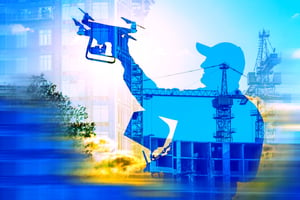How can different types of weather affect your aerial drone surveying?
It's important to understand the different types of weather and their effects on drone flight. In this article, we'll explore how different types of weather affect drones in aerial surveying.
 Drones are a cost-effective and efficient alternative to traditional surveying methods. However, weather conditions can have a significant impact on drone performance, and it is important to understand the different types of weather and their effects on drone flight. In this article, we'll explore how different types of weather affect drones in aerial surveying.
Drones are a cost-effective and efficient alternative to traditional surveying methods. However, weather conditions can have a significant impact on drone performance, and it is important to understand the different types of weather and their effects on drone flight. In this article, we'll explore how different types of weather affect drones in aerial surveying.
Wind
Wind is one of the most significant weather factors that can affect drone flight. Strong winds can cause a drone to drift off course, making it difficult to maintain stability and control. In high winds, a drone may be unable to maintain altitude, and it may even crash. In aerial surveying, wind can also affect the accuracy of the data collected by your drone, making it important to avoid flying in strong winds.
Rain and Moisture
Rain and moisture can cause serious problems for drones, as water can damage sensitive electronic components and interfere with the drone's flight controls. Moisture can also cause condensation on the lens of the camera, affecting the quality of the images and data collected by the drone. In aerial surveying, it is generally recommended to avoid flying in heavy rain or high humidity conditions.
Temperatures
Temperature can also have an impact on drone performance, as extreme temperatures can cause problems with battery performance and other electronic components. In hot weather, the battery may discharge more quickly, reducing your drone's flight time. In cold weather, the battery may not perform as well, and it may even shut down due to the low temperature. In aerial surveying, it is important to consider temperature when planning a drone flight, as these conditions can affect the accuracy and reliability of the data collected.
Fog and Cloud Cover
Fog and cloud cover can also affect drone performance, as they can reduce visibility and make it more difficult to see and control your drone. In aerial surveying, these conditions can also affect the quality of the images and data collected, as your drone may not be able to see the ground clearly. It is generally recommended to avoid flying in conditions of low visibility, such as heavy fog or thick cloud cover.
Understanding the different types of weather and their effects on drone flight is essential for your aerial surveying projects, as it will help them make informed decisions about when and where to fly your drone.
Visit rockrobotic.com to learn more about ROCK Robotic's survey-grade LiDAR hardware and software.
![ROCK-robotic-community-logo.png]](https://learn.rockrobotic.com/hs-fs/hubfs/ROCK-robotic-community-logo.png?width=250&height=50&name=ROCK-robotic-community-logo.png)